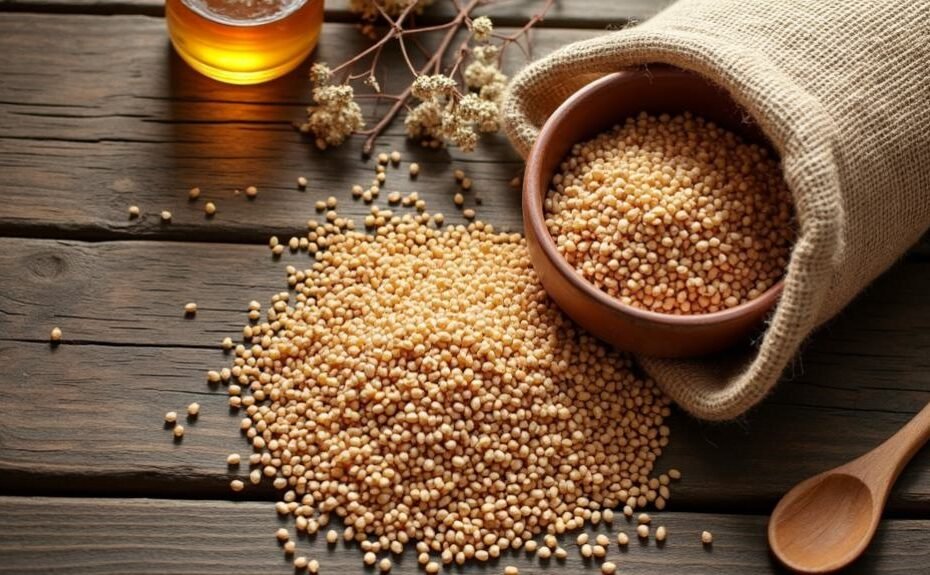Buckwheat is a nutritious pseudocereal with high protein content, essential amino acids, and rich antioxidant compounds including rutin and quercetin. Despite not being a true grain, it provides gluten-free nourishment with heart-healthy properties and anti-inflammatory benefits.
The cardiovascular benefits, nutritional profile, proper preparation methods, potential side effects, and dietary applications of buckwheat, along with its suitability for various dietary restrictions including gluten intolerance, is explored in this post, below.
Trumpai
- Buckwheat provides cardiovascular benefits by reducing cholesterol and triglycerides with its high fiber content promoting digestive health.
- Each 100g of boiled buckwheat contains 118 calories with 4.3-5.7g protein, 21-33.5g carbohydrates, and 2.1-4.5g fiber.
- Potential side effects include allergic reactions, digestive discomfort, and possible complications for those with kidney conditions.
- Recommended daily intake ranges from 70-100g, though dosage guidelines lack standardization due to insufficient clinical research.
- Compared to quinoa, buckwheat has twice the niacin, provides vitamin K, contains more antioxidants, and has a lower glycemic index.
Potential Benefits
Buckwheat may improve cardiovascular health by reducing cholesterol, triglyceride levels, and hypertension. It may outperform both soy protein and casein in lowering blood cholesterol, while also potentially improving blood glucose control.
Buckwheat may provide digestive benefits through its high fiber content, which may promote regular bowel movements and relieve constipation. As a potential prebiotic, it may enhance gut microbiota diversity and function as a superior gluten-free alternative with greater nutrient density than typical rice-based products.
Buckwheat may contain antioxidant compounds, including rutin and quercetin, which may combat oxidative stress while exhibiting anti-inflammatory properties by inhibiting pro-inflammatory enzymes, potentially reducing chronic disease risk.
When consuming buckwheat, drinking water is important to maximize its fiber benefits.
The appropriate consumption amount may vary by individual, so please consult with a doctor before making significant dietary changes.
Nutritional Information, Calories
Nutritional Information, Calories
Buckwheat contains 343 calories per 100g raw and 118 calories per 100g when boiled (155 calories per cup).
Buckwheat may provide the following nutritional content:
Macronutrients
- Protein: 4.3-5.7g per serving
- Fats: 1-2g (heart-healthy)
- Carbohydrates: 21-33.5g per serving
- Fiber: 2.1-4.5g per serving
- Sugar: Minimal
Micronutrients
- Manganese: May support bone development and metabolism
- Magnesium: 65mg per 100g boiled, which may support muscle and nerve function
- B vitamins: May help with energy production and cell health
Health Benefits
Buckwheat may serve as an excellent gluten-free alternative to refined grains.
It may be particularly beneficial for those seeking nutritional balance in their diet.
Common Foods Containing Buckwheat
- Buckwheat flour pancakes
- Soba noodles
- Kasha (roasted buckwheat groats)
- Buckwheat porridge
- Gluten-free baked goods
Nutritional values may vary depending on preparation methods.
Dosage may vary by individual, so please consult with a doctor or your personal trainer regarding how much buckwheat to incorporate into your diet.
Drinking water is important when consuming high-fiber foods like buckwheat.
Potential Side Effects
Potential side effects of buckwheat may include allergic reactions, digestive discomfort, and complications for those with kidney issues or diabetes.
Allergic reactions may range from mild skin rashes and swelling to severe anaphylactic shock in extreme cases. Individuals with rice allergies may experience cross-reactivity due to shared protein antigens.
Digestive discomfort may occur, particularly for people unaccustomed to high-fiber foods. Bloating, gas, and nausea may develop, especially when consumed in large quantities.
Drinking water is important when consuming buckwheat to help reduce these digestive effects.
Buckwheat may contain moderate oxalate content, which could potentially worsen existing kidney conditions. Patients with diabetes may need to monitor their blood glucose levels carefully, as buckwheat may lower blood sugar levels and potentially interfere with medication efficacy.
Before adding buckwheat to your diet, please consult with a doctor if you have any pre-existing health conditions or concerns about potential side effects.
Use and dosage recomendations
Recommended dosage for buckwheat may be 70-100g daily** for glucose tolerance in diabetes management, though appropriate intake likely varies based on individual health factors**.
Buckwheat may lack standardized dosage guidelines due to insufficient clinical research, despite its popularity in health-conscious diets. The recommended 70-100g (approximately 2.5-3.5 ounces) may benefit blood sugar control, but factors such as age and health status may greatly affect appropriate intake levels.
Safety considerations may include potential interactions with antidiabetic medications, which may necessitate blood sugar monitoring and possible medication adjustments.
Dosage may vary significantly across different forms of buckwheat (flour, groats, noodles, and sprouted versions), so doctor consultation is strongly recommended before therapeutic use.
The high-fiber content may warrant gradual introduction to prevent digestive discomfort. Drinking water is important when consuming high-fiber foods like buckwheat.
Those with allergies may need to exercise caution. For maximum benefit and safety, consumers may prioritize product labeling information over generic dosing recommendations.
Buckwheat Vs Quinoa Comparison
Buckwheat vs Quinoa: Comparison
Nutritional Advantages of Buckwheat
- Contains twice the niacin (vitamin B3) compared to quinoa.
- Provides vitamin K (completely absent in quinoa).
- Delivers superior antioxidant levels.
- Contains significantly less fat.
- Has a lower glycemic index, beneficial for blood sugar management.
- Offers resistant starch that promotes gut health.
- Better choice for cardiovascular health and glucose control.
Nutritional Advantages of Quinoa
- Higher protein content (4.4g vs 3.4g per 100g).
- Richer in multiple B vitamins (B1, B2, B6, B9).
- Contains more vitamin E.
- Provides greater vitamin variety overall.
- Better option for protein density.
Shared Attributes
- Similar fiber content.
- Both require specific cooking methods.
- Both considered nutritious pseudocereal alternatives.
Key Considerations
- Blood glucose management: Buckwheat preferred.
- Protein requirements: Quinoa preferred.
- Heart health: Buckwheat offers more benefits.
- Digestive health: Buckwheat’s resistant starch provides additional advantages.
What diseases or symptoms can this potentially help treat or alleviate?
Buckwheat may help treat diabetes, cardiovascular conditions, digestive disorders, neurological issues like Alzheimer’s, and circulatory problems such as varicose veins.
For diabetes management, buckwheat may improve insulin sensitivity and moderate blood sugar levels. Its D-chiro-inositol content may support glucose homeostasis.
Regarding cardiovascular health, buckwheat may reduce cholesterol, triglycerides, and blood pressure while potentially improving lipid profiles. The rutin and quercetin in buckwheat may strengthen blood vessels and reduce inflammation associated with atherosclerosis.
The high fiber content in buckwheat may benefit digestive disorders by promoting gut microbiota diversity and regular bowel movements.
Emerging evidence suggests neurological benefits, as rutin in buckwheat may have potential applications for Alzheimer’s disease.
For circulatory problems, buckwheat may enhance circulation and potentially alleviate symptoms of varicose veins by strengthening vascular structure and improving blood flow.
Before using buckwheat therapeutically, please consult with a doctor as individual responses may vary.
Frequently Asked Questions
Is Buckwheat Gluten-Free?
Yes, buckwheat is gluten-free. Buckwheat may possess properties making it naturally gluten-free, as it may belong to the Polygonaceae family. Individuals with gluten sensitivity may safely consume this pseudo-cereal without adverse reactions.
Important entities related to buckwheat include:
- Pseudo-cereal classification
- Polygonaceae botanical family
- Gluten-free status
- Suitability for those with gluten sensitivity
Can You Eat Buckwheat Raw?
No, you should not eat buckwheat raw. Raw buckwheat may be consumed after proper preparation through soaking, sprouting, or fermenting. These methods may enhance raw buckwheat benefits by improving digestibility and nutrient bioavailability, making it suitable for diverse raw buckwheat recipes.
Important attributes related to raw buckwheat include its nutritional content (protein, fiber, minerals), potential antinutrients that are reduced through preparation, and its versatility in uncooked culinary applications. Consuming properly prepared raw buckwheat may support digestive health and provide essential nutrients.
How Do You Cook Buckwheat Properly?
To cook buckwheat properly, rinse it first, then optionally toast it, use a water ratio of 1.5:1 to 2:1 (150-200 ml water to 100 g buckwheat), simmer covered for 10-15 minutes, and let it rest for 10-30 minutes.
Buckwheat may benefit from thorough rinsing before cooking to remove any debris or bitter compounds. The toasting step may enhance the nutty flavor of the buckwheat grains. The water-to-buckwheat ratio may vary depending on desired texture – using less water (150 ml per 100 g) may result in firmer grains, while more water (200 ml per 100 g) may produce softer results. Drinking water during meals with buckwheat may help with digestion. The cooking time may vary based on buckwheat type, with roasted buckwheat (kasha) possibly cooking faster than raw buckwheat groats. The essential resting period allows the buckwheat to absorb remaining moisture and achieve optimal texture.
Is Buckwheat Keto-Friendly?
No, buckwheat is not keto-friendly. Buckwheat may contain high carbohydrate content (17.2g net carbs/100g). Those following ketogenic diets may explore buckwheat substitutes like almond flour or coconut flour for buckwheat recipes requiring lower carb alternatives. Key entities include buckwheat, ketogenic diet, carbohydrates, almond flour, and coconut flour.
Where Did Buckwheat Originate?
Buckwheat originated in Southeast Asia. It may have appeared approximately 5-6 thousand years ago, with historical origins that may be traced to ancient cultivation in Northern China around 4000 BCE. Buckwheat may show early cultural significance across multiple Asian regions. Important entities related to buckwheat include its geographical origin, historical timeline, and cultural importance in Asia.
References
- https://www.webmd.com/diet/health-benefits-buckwheat
- https://www.health.harvard.edu/heart-health/grain-of-the-month-buckwheat
- https://pubmed.ncbi.nlm.nih.gov/26270637/
- https://www.medicalnewstoday.com/articles/325042
- https://colsa.unh.edu/blog/2023/11/get-healthy-himalayan-tartary-buckwheat-discover-many-health-benefits-superfood
- https://www.healthline.com/nutrition/foods/buckwheat
- https://www.bbcgoodfood.com/health/nutrition/health-benefits-buckwheat
- https://www.precisionnutrition.com/encyclopedia/food/buckwheat
- https://www.pccmarkets.com/product-info/bulk/bobs-red-mill-raw-buckwheat-groats-872815/
- https://www.rxlist.com/supplements/buckwheat.htm

